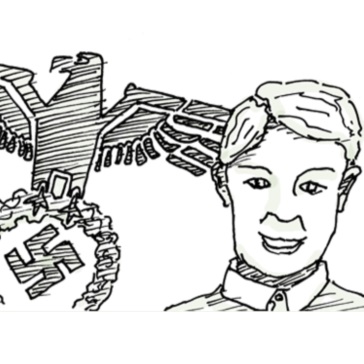
Audience: KS4
Subject: English
Topic: Literature, Moral, Responsibility, Nature, Murder, Island, Children
Question: In ‘Lord of the Flies’ who is responsible for the murders on the island?
Author: Stephanie Nelson
Description
This mystery can be used before embarking on study of ‘Lord of the Flies’ by William Golding to gain a general overview of the plot and characters. Or, it could be used after reading the text, to engage with themes in the novel such as moral responsibility and the nature of evil, especially if the middle to higher ability questions is used.
The Mystery is designed to allow pupils to explore how the deaths on the island have taken place. For lower ability pupils and those who have not read the text this mystery will help them sequence events in the novel and assign blame for the murders to certain characters in the novel – i.e. all of the boys are responsible in some way for Simon’s murder and Roger (under the leadership of Jack) for Piggy’s murder. Students may form other conclusions, such as delirious hunger and lack of adult supervision as factors contributing toward the boy’s deaths. Pupils will begin to consider the main themes of the novel and the message Golding was trying to give through the text.
However, the higher ability question, ‘Who or what is the beast?’ should lead higher ability students to the comment Golding was wishing to make regarding human nature and the effects of evil. It could lead in to discussions regarding social and moral responsibility for actions and the beast which is within all of us.

Audience: KS4
Subject: History / English
Topic: US History, Law, Politics, Economy, Culture, 20th Century, Racism, Prejudice
Question: Why were Black people treated badly in Twentieth Century America?
Author: Elizabeth Doyle
Description
The Spanish Armada is a significant event during the Tudor period, and one which sheds light upon a number of key themes that emerge during the study of ‘The Making of the UK’. These include Catholic and Protestant religion, power, warfare, international politics and questions of succession to the throne. It is also an event whose outcome could not have been predicted, but provides a good opportunity for students in Key Stage Three to consider a range of factors and evaluate the contribution each event or combination of events makes to the ultimate failure of Philip of Spain’s campaign.
While the students using the basic set are asked to identify the reasons for the launch of the Armada and its outcome, the standard set of statements are intended to assist students in the skills of evaluation, and the assessment of the importance of religious conflict as a cause of the venture. More able students could then consider how much the planning and tactics of those involved were undermined by forces beyond human control. It is hoped that this will help to develop the higher-order strategies of analysis and evaluation that will lead to success in Key Stage Four.

Audience: KS3/KS4
Subject: English, History
Topic: German History, Holocaust, The Boy in the Striped Pyjamas, Jews, Genocide, Nazi
Question: Emil’s younger sister has asked him what happens to the people who are being deported, and why they are being taken away. What do you think he would tell her?
Author: Elizabeth Doyle
Description
This mystery would be useful as part of a study of Nazi Germany in Key Stage 3 or 4 History, and also to provide historical context for any class examining novels based around the Holocaust, such as ‘The Boy In The Striped Pyjamas’ or ‘When Hitler Stole Pink Rabbit’ in English.
It is hoped that this mystery will help students in their mid teens to understand the events of the Holocaust from the point of view of someone their age. Emil has to deal with the difficulty of trying to understand what could be happening, and also to deal with realisation that people whom he loves and trusts may be complicit in it. Bruno in ‘The Boy In The Striped Pyjamas’ is very young and has innocence on his side, whereas an older child such as Emil may have more information and understanding to process.
Subject: PESHE, English
Topic: PSHE, Citizenship, Relationships, English
Question: Why didn’t Amy come to school today?
Author: Anne de A’Echevarria
Description
Amy is a mystery that focuses on typical friendship problems which can often arise within the primary school age group. It does this through a young character called Amy and her experiences at school. Students must read information then organise their ideas to help them discuss the question: ‘Why didn’t Amy come to school today?’
The mystery would fit well within the KS1 PSHE/Citizenship curriculum; could also be used to support the development of speaking and listening within the English curriculum; and could be used to foster the development of generic higher order thinking skills.
Learning outcomes:
PSHE/Citizenship
The mystery could be used to stimulate discussion and drama for learning activities in the area of developing good relationships. Relevant learning objectives might include:
- To recognise how their behaviour affects other people, to care about other people’s feelings and to try to see things from their points of view
- To listen to other people, and play and work cooperatively
- To understand that there are different types of teasing and bullying, that bullying is wrong, and how to get help to deal with bullying
English
The mystery could be used to support the development of group discussion and interaction. Relevant learning objectives might include:
- To take turns in speaking
- To relate their contributions to what has gone on before - building on the ideas of others
- To take different views into account
- To extend their ideas in the light of discussion
Thinking skills
Learning objectives relating to the generic thinking skills that the mystery aims to develop might include:
- To justify ideas with reasons
- To form a well-structured explanation
- To speculate and draw inferences from information
Subject: Science/English
Topic: The everyday effects of light; Periodic changes; Group discussion and interaction
Question: Why did Jenny lose her shadow?
Author: Anne de A’Echevarria
Description
‘Jenny’s Shadow’ can be used within the science curriculum; to support the development of speaking and listening within the English curriculum; and can also be used to foster the development of generic higher order thinking skills.
18 slips are provided in the task – these cover the story of Jenny and her friends doing an experiment at school, scientific facts with playful illustrations, background information on the activity and some red herrings. Some of these involve basic diagrams, tables and mini maps to help students come to a conclusion.
Science
The mystery could be used to develop and reinforce understanding of the everyday effects of light (that light travels from a source; that light cannot pass through some materials, and how this leads to the formation of shadows; that light is reflected from surfaces), as well as periodic changes - how the position of the Sun appears to change during the day, and how shadows change as this happens.
This task may also be useful to stimulate discussion relevant to the theme of scientific enquiry, as pupils use their scientific knowledge and understanding to explain Jenny’s and her friends’ observations, to evaluate their work and describe its limitations.
English
The mystery could also be used to support the development of group discussion and interaction, as well as the development of generic thinking skills.
Among others, learning objectives for science might include developing understanding that:
- light travels from a source
- light cannot pass through some materials, and how this leads to the formation of shadows
- light is reflected from some surfaces
There is also the added learning outcome of using their scientific knowledge which they have gained prior to, or during, this task, to explore, explain and discuss Jenny’s experiment and her findings.
English
- To take turns in speaking
- To relate their contributions to what has gone on before - building on the ideas of others
- To take different views into account
- To extend their ideas in the light of discussion
- Thinking skills
- To justify ideas with reasons
- To form a well-structured explanation
- To speculate and draw inferences from information
Subject: PSHE/English/Science
Topic: Confidence and responsibility, Citizenship, Group discussion and interaction
Question: Should Emma be allowed to keep Pip?
Author: Anne de A’Echevarria
Description
This mystery has been designed particularly with the PSHE/citizenship and English curriculum in mind. However, it also has cross curricular links with the science curriculum in relation to ‘Life processes and living things: Humans and other animals’, and can also be used to foster the development of generic higher order thinking skills.
It has 25 slips all about a young girl called Emma, who finds a dog in the park. Although she is really fond of the dog (Pip), students must consider all aspects of Emma's life and decide whether she should be allowed to keep him or not. Snippets are provided which range from information on Emma's family, her pocket money, friends and the various responsibilities of actually owning and taking care of a dog.
PSHE/citizenship
The mystery could be used to stimulate discussion in two particular areas:
1) Developing confidence and responsibility
Relevant learning objectives might include:
- to recognise what is fair and unfair, and what is right and wrong
- to share their opinions on things that matter to them and explain their views
- to recognise, name and deal with their feelings in a positive way
2) Preparing to play an active role as citizens
Relevant learning objectives might include:
- to take part in discussions with small groups and the whole class
- to take part in a simple debate about a topical issue
- to recognise choices they can make, and recognise the difference between right and wrong
- to realise that people and other living things have needs, and that they have responsibilities to meet them
English
The mystery could also be used to support the development of group discussion and interaction:
Relevant learning objectives might include:
- To take turns in speaking
- To relate their contributions to what has gone on before - building on the ideas of others
- To take different views into account
- To extend their ideas in the light of discussion
Science
The mystery also has connections with the science curriculum in relation to ‘Life processes and living things: Humans and other animals’. It could be used to stimulate discussion about animal welfare, particularly ‘how to treat animals with care and sensitivity’.
Thinking skills
Learning objectives relating to the generic thinking skills that the mystery aims to develop might include:
*To justify ideas with reasons
*To form a well-structured explanation
*To speculate and draw inferences from information

Audience: KS1/2
Subject: RE, English
Topic: Christmas, Baboushka, Russia, Bethlehem, Jesus, Kings, Religious Education, English, Story, Nativity, Mary, Joseph
Question: Why didn’t Baboushka follow the kings to Bethlehem?
Author: Lynne Flint
Description
This mystery aims to teach children about the Christmas story and the people involved in Jesus’ birth. It uses details associated with the Nativity story and mentions some of the symbols and traditions related to the Christian festival of Christmas.
Religious Education objectives covered:
- Talk about the Christmas story and the impact it has had on the world.
- Talk about how Christians believe that Jesus is God’s gift to the world.
- Use religious vocabulary associated with the nativity story.
- Talk about the mystery of the events of the nativity.
Throughout this mystery, children will have the chance to use the vocabulary associated with the nativity story/Jesus' birth and understand the worldwide impact of the topic.
English objectives covered:
- Becoming very familiar with key stories, fairy stories and traditional tales, retelling them and considering their particular characteristics.
- Making inferences on the basis of what is being said and done.
- Predicting what might happen on the basis of what has been read so far
This mystery can be used alongside the story of Baboushka to predict and infer reasons for events during the story. Children can use the clues to infer what this could mean in relation to Baboushka’s actions. They can predict what she may do from clues given and what has already been read.
Audience: KS2
Subject: Citizenship, English, PSHE
Topic: Health, Safety, Lifestyle, Development, Character, Group Discussion, Interaction
Question: Why did Tyke Turner steal?
Author: Anne de A’Echevarria
Description
Why did Tyke Turner steal?’ is a mystery about the pressures that a young girl faces both at home and at school that lead her to steal a smartphone.
The mystery would fit well within the PSHE/Citizenship curriculum; could also be used to support the development of speaking and listening within the English curriculum; and could be used to foster the development of generic higher order thinking skills.
There are 15 slips of information provided on Easy and Medium setting, with an addition 3 being added in Hard.
PSHE/Citizenship
The mystery could be used to stimulate discussion and drama for learning activities in two key areas:
1) Developing a healthy, safer lifestyle, and
2) Developing good relationships and respecting the differences between people.
Key learning outcomes that could arise from the mystery and related activity might include:
Developing a healthy, safer lifestyle
- Understanding that pressure to behave in an unacceptable or risky way can come from a variety of sources, including people they know
- Knowing how to ask for help and use basic techniques for resisting pressure to do wrong
- Developing good relationships and respecting the differences between people
- Understanding that their actions affect themselves and others, to care about other people's feelings and to try to see things from other people's points of view
- Being aware of different types of relationships, including those between friends and families, and developing the skills to be effective in relationships
- Realising the nature and consequences of teasing, bullying and other aggressive behaviours, and how to respond to them and ask for help
English
The mystery could also be used to support the development of group discussion and interaction:
Key learning outcomes that could arise from the mystery activity might include:
- Making contributions relevant to the topic and taking turns in discussion
- Varying contributions to suit the activity and purpose, including exploratory and tentative comments where ideas are being collected together, and reasoned, evaluative comments as discussion moves to conclusions
- Qualifying or justifying what they think after listening to others' questions or accounts
- Dealing politely with opposing points of view
- Using different ways to help the group move forward: including summarising the main points, reviewing what has been said, clarifying, drawing others in, reaching agreement and considering alternatives
Thinking skills
Learning outcomes relating to the generic thinking skills that the mystery aims to develop might include:
- Justifying ideas with reasons
- Asking questions to check understanding
- Evaluating and building on the ideas of others
- Forming well-structured explanations
- Developing their understanding through speculating, inference, hypothesising and exploring ideas
Audience: KS2
Subject: Science/English
Topic: Evolution, Inheritance, Animals, Humans, Group discussion, Group interaction
Question: Where does Pebbles live?
Author: Anne de A’Echevarria
Description
This mystery has been designed to support the science and English curriculum. It can also be used to foster the development of generic higher order thinking skills.
Science: 'Where does Pebbles live?' could be used to support ‘Evolution and inheritance’ or ‘Animals, including humans’.
English: The mystery could also be used to support the development of group discussion and interaction.
Science (particularly for 10-11 year olds)
Exploring how animals, such as the Arctic Fox, have adapted to their environment. The mystery could be used as a precursor to further research. The learners will, of course, be keen to work out who Pebbles is exactly, which could lead to an exploration of a range of different adaptations across different habitats and analysis of the advantages and disadvantages of specific adaptations.
Science (particularly for 8-9 year olds)
This resource could also be used to support revising the concept of food chains by identifying the food chain embedded in the mystery, prior to constructing a variety of other chains; identifying producers, predators and prey.
English
Relevant learning objectives might include:
- To take turns in speaking
- To relate their contributions to what has gone on before, building on the ideas of others
- To take different views into account
- To extend their ideas in the light of discussion
Thinking skills
Learning objectives relating to the generic thinking skills that the mystery aims to develop might include:
- To justify ideas with reasons
- To form a well-structured explanation
- To speculate and draw inferences from information
Subject: English
Topic: Macbeth, Shakespeare, GCSE, Influences, Witches, Bravery, Theatre, Drama
Question: What are the key influences on the behaviour of Macbeth?
Author: Elizabeth Doyle
Description
This resource is designed to help students ‘unpack’ and analyse the events leading up to Macbeth’s decision to become a multiple murderer in order to cultivate and then fulfil the ambition to seize the throne. Macbeth’s various struggles with conscience, the temptations of power and the pressure placed on him by his wife ‘weave in and out’ of the text.
Lower ability students could benefit from guidance so they can identify the evidence to support their conclusions about Macbeth’s motivation. More able students can discuss Macbeth’s character, but it is hoped that this exercise will help them to evaluate the importance of each factor, and the ways that Macbeth’s actions and statements reflect the evolution of his character and relationships over the course of the play.
There are twelve slips in the ‘easy’ setting of the app.
Six slips are added in the ‘medium’ level, designed to build on the work done within ‘easy’, but to explore more deeply Macbeth’s character, in particular his good qualities, to highlight the tragedy of the flaws which contribute to his deeds and ultimate downfall. Hopefully students will have a more developed awareness of his struggle in the choice between the good and evil path.
The extra six slips in ‘hard’ are intended to encourage higher order analysis of the relationship between Macbeth and Lady Macbeth, and the way its dynamics fluctuate and change during the course of the play. It is hoped that students will reflect on Macbeth’s deepest motivation and willingness to supress his conscience in order to proceed in his plans. They could also notice the language he uses; he can speak both with affection towards his wife earlier on in the play, but with coldness later on. He also uses language that is resonant of judgement and damnation in his soliloquies, and this is also interesting.
Possible learning outcomes for students include:
- Identify evidence to support conclusions about Macbeth’s motivation
- Evaluate the importance of motivational factors
- Evaluate how Macbeth’s actions and statements reflect his character development and relationships over the course of the play
- Develop awareness of Macbeth’s struggle between good and evil
- Analyse how the relationship between Macbeth and Lady Macbeth fluctuates
- Discuss the language Macbeth uses and how this varies






